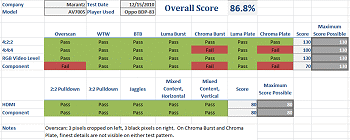
Introduction
In 2009 I got to review the Marantz AV8003 processor and amp, and they helped to convince me of the benefits of separates over a receiver, and with how important it is overall to the performance of your whole system. With the Marantz pair, my speakers and CD player sounded better than they ever had before, and the system was virtually silent when muted compared to the bit of noise I get out of my speakers from most receivers. Unfortunately, I had to eventually return the pair to Marantz so when they announced a new processor at a more affordable price point, I did everything I could to get my hands on it and now have the pleasure of reviewing it as well.
In this review, we take a look at the AV7005 7.1 A/V Surround Sound Processor (SSP), which has an excellent feature set, including fully balanced analog audio XLR outputs for all channels.
Specifications
- Design: 7.1 A/V Surround Sound Processor (SSP)
- Codecs: All, Including Dolby TrueHD and DTS-HD Master Audio
- Video Connections: HDMI 1.4a (5 Rear In, 1 Front In, 2 Out), Component (4 In, 2 Out), Composite (5 In, 2 Oout), No S-Video
- Audio Connections: RCA Stereo (7 In, 2 Out), Optical (3 In, 1 Out), Coaxial Digital (3 In, 0 Out), 7.1 Multichannel (1 In, 1 Unbalanced Pre-out, 1 Balanced Pre-out), USB (1 Front)
- Other Connections: Ethernet (Internet Radio, Firmware), 12V triggers (2), RS-232, IR (1 In), 2nd Zone (Composite Video, Component Video, Stereo Audio), 3rd Zone (Stereo Audio), Headphone Jack (6.3mm)
- Dimensions: 7.4″ H x 17.4″ W x 16″ D
- Weight 22.3 Pounds
- MSRP: $1,500 USA
- Marantz
Design
The AV7005 shares the new look of the Marantz AV components this year. The front is very clear, with just a power toggle, controls for volume and source selection, and a round display showing the current input and volume level. Hidden behind a panel is a larger LCD with more information, front panel inputs including HDMI, and additional controls. With the panel shut, it’s a very clean look that many people will want to display instead of hiding inside of an AV rack. Thankfully, Marantz kept the AV7005 depth a little shallower than normal components, which I’ve found makes it much easier to slide in and out of a rack while hooking up cables.
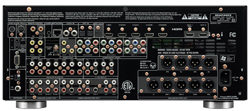
Build quality on the Marantz is good and the unit feels nice and solid. When I removed it from the box it was much lighter than I expected it to be, but I’ve been reviewing a lot of receivers recently and when you remove the amp section you lose a lot of that weight. The selection of inputs and outputs on the Marantz is well rounded, with 6 HDMI inputs, 2 HDMI outputs, balanced and unbalanced outputs, a 7.1 analog input, a MM phono stage, Ethernet, HD Radio, and plenty of composite, component, and RCA stereo inputs. One thing missing is S-Video inputs, but those are quickly becoming extinct on all receivers and processors out there. I also would have liked to see a stereo XLR input, but the lack of one didn’t cause any issues.
The most common complaint on the previous AV8003 was the inability to do Audyssey processing on TrueHD and DTS-MA bitstreams. I always felt this was a bit overblown, as you could simple send the audio as PCM instead and it could perform Audyssey on that, but for some people it was a deal breaker. On the AV7005 this is no longer an issue, and it can use Audyssey MultEQ on virtually all digital sources. It won’t work on 24/192 bitstreams but it can handle 24/192 content if it is sent as PCM. As there are only a half dozen 24/192 Blu-ray titles out there this shouldn’t be a limitation at all in real world use. One thing to note is that the AV7005 will not accept native DSD audio over HDMI, so your player will have to convert it to PCM first, or you will need to use the analog outputs of your SACD player.
Setup
Configuring the AV7005 in my system was a very straight forward affair. Setting up the inputs to certain HDMI and digital inputs was very easy, as well as configuring the video processor for each input. One nice feature was the ability to use a web interface from my computer to rename the inputs on the system using a keyboard instead of using an onscreen keyboard, which makes renaming these inputs far easier than usual. Once I had my inputs setup, renamed, and the unused inputs disabled, I went about running Audyssey.

In the past I had always found Audyssey to be a little bit of hit and miss with its settings. Sometimes the distances were pretty good, but sometimes they were off. However, with the recent receivers that I’ve used, it’s been much better and the Marantz is no exception. It did incorrectly tell me that I had one speaker hooked up out-of-phase on my initial attempt, but I re-ran it multiple times and never saw this behavior again, so I’d likely attribute this to background noise or something else that caused an error in the measurement. The speaker distances were nailed down by Audyssey with exacting precision, and I didn’t need to adjust any of the settings. It also got the crossover for my speakers correct which was good as the last room correction system I used set it too high, though the position of them has not changed since then.
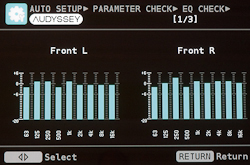
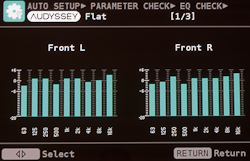
I went ahead and measured all 8 positions around our couch, using the Audyssey Setup Guide at AVS (link this to: http://www.avsforum.com/avs-vb/showthread.php?p=14456895 #post14456895) as a reference. Once this was complete, a nice feature on the AV7005 was the ability to browse the graphs of the corrections applied to each channel in the system. Typically, most receivers will only show you the crossovers applied to each channel and none of the EQ, but the Marantz let me view this as you can see. You also have your choice of which Audyssey curve to apply (Standard, Flat, Front) depending on how you want the final result to sound and you can see in the images how the different curve affects the EQ applied to the speakers. Overall the Audyssey setup process was very simple and straight forward, as it should be.
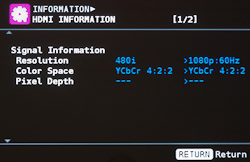
One feature that I particularly liked in the menu system of the Marantz is the ability to view exactly what type of data is entering over HDMI, and what data it is outputting. For example, my TiVo HD outputs over HDMI as YPbPr 4:4:4 and the Marantz would output the exact same thing. A Blu-ray player that I had in for review output everything as x.v.Color 4:4:4, even when Deep Color was disabled. For most people this information might not be important, but if you know that your display has issues with certain types of color information, this can be very helpful, and you can read more about this on the bench test section.
In Use
Now that everything was configured, I finally got a chance to see what the Marantz could do. One of the first things I wanted to do was try out the iOS application and the network streaming for audio. I have a Squeezebox Touch and absolutely love it, but sometimes I find it annoying to need to use multiple devices just to listen to an Internet radio stream. I’ll be very direct that while the Squeezebox is still a better streaming device than the AV7005, this is the first receiver/processor implementation that I could actually live with. Streaming Internet Radio was easy, and adding my preferred stations to my favorites was very simple to do. Browsing was pretty quick with the on screen display, though not quite as easy with the iOS application. Similarly, browsing my large networked library of music was actually easy to do for the first time and playback of mp3’s and FLAC files were perfect with no skipping during my testing. The previous Marantz had an issue with GIF vs. JPEG images for album cover art, but I didn’t see that same issue popping up this time. I think if Marantz can make a couple of tweaks to the iOS application and how it browses, then this would be a great music streaming device for a lot of people.


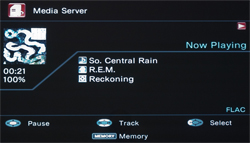
As much as I love the music streaming, most people probably care more about the audio quality of the Marantz. For one of my tests, I put on Diana Krall – Live in Paris and played it back at levels that would drive my wife crazy. The Marantz did a fantastic job here, with a wide, open soundstage, great detail, and a very black background. When I used a receiver as a preamp in the past, in quiet passages of music, or with nothing playing, I could always hear a bit of static noise since the amplifier section would bleed into the preouts inside of the receiver. With the Marantz this was dead silent even over the unbalanced outputs, letting me hear the smaller details in the music better. Of course Diana Krall almost always sounds wonderful, and her voice was particularly wonderful through the Marantz.
Another good test of a processor or receiver for music is putting on an album that I know is poorly recorded and seeing how it sounds. With the better equipment that I’ve listened to, I want to stop listening quickly as the sound is too harsh and abrasive, just grating at my ears. On lesser components, there’s a fog obscuring some of the details, which helps to hide this harshness and let you listen more easily. It seems strange to suggest that certain music should be listened to on lower quality components, but with lower quality recordings I can find that to be true.

Listening to “High Violet” from The National, I was reminded how poor the album sounds when I really pay attention. The music and lyrics are wonderful, and I’ve listened to it countless times this year, but when you turn it up and sit down, the recording just shouts at you without a break. I had to either give up listening to the album or just have it on as background music as the Marantz was ruthless in resolving the detail, not sparing my ears at all. I’ve since resolved that most modern rock recordings I’ll have to acquire on vinyl now and rip them myself, as the vinyl versions don’t suffer from this malady, and you get far greater dynamic range in the recordings.
The Marantz won’t do DSD over HDMI for my SACD collection, but when combined with my Sony 5400ES SACD player, it will accept those multichannel recordings as 24/176.4 PCM and apply room correction, which should still provide a fantastic experience. With Brothers in Arms from Dire Straits, I don’t believe that I was lacking anything at all from this compromise. There are very, very few components out there that can do room correction to DSD without first converting it to PCM, so if you plan to use room correction this issue is really a moot point. With So Far Away, the drums that open the track came from all around, moving not just around my head, but closer and further away in depth in the soundstage as well. Unlike earlier albums that didn’t understand how to use surround for audio, Brothers in Arms pulls you into the music and makes it a much more immersing experience, without feeling like a cheap trick. I lost myself in the album, and here Audyssey really seemed to help out as the bass wasn’t boomy, and there was seemingly no gap between the front and surround speakers.
While I sometimes will listen to films at reference volume when my wife and son are away, often I’m going to be listening to things at 25-30 db below reference. As most people know, often you’ll have surround effects, or even dialogue, that isn’t mixed to be easily heard at that level and so you miss out on many of the audio cues in films and on television. The AV7005 includes Audyssey Dynamic Volume, which is designed to correct for this issue while also taking into account the acoustics of your room that were determined by Audyssey room correction. My prior experiences with volume equalization systems were less than stellar, as they seemed to put everything at the exact same level, much like compressing the dynamics of a modern recording. With Audyssey I seemed to gain the extra information I was missing in these channels before, but without totally squeezing the dynamic range down to almost nothing.
Just watching football on TV became more immersing as the ambiance of the crowd was suddenly more prevalent, but it didn’t overwhelm the sounds of the quarterback barking the snap count, or a big hit from a linebacker. Instead it just brought those effects up to a level where you were aware of them, but without totally compromising the surround mix. Since I think most people don’t listen to films at reference level, at least not all of the time, I think Dynamic Volume is a feature that I’d probably enable, but each individual can determine that for themselves.
There are a couple of things on the AV7005 that bother me, but they could all possibly be addressed by firmware or other means. The most pressing issue is that the IR sensor on my unit seems to have an exceptionally poor field of view. Components that I don’t have to insert media into live inside of my Salamander Synergy rack with perforated metal doors and so far nothing has had issues with the remote. However, the AV7005 often missed commands from the Harmony and didn’t turn on, frustrating myself and my family when it did so. I’m going to purchase an IR repeater to fix it, and asking online has only found one other person with the issue so it might just be a bad sensor in a couple units, but it’s something to be aware of.
The other issue I had was relatively minor. When you mute the volume, you get a solid grey box on the screen with text that says MUTE in there. Most plasma sets, including mine, are pretty good about image retention now but it would still be best if this item flashed on the screen instead of remaining solid, or you had the option to disable it in the settings.
On The Bench
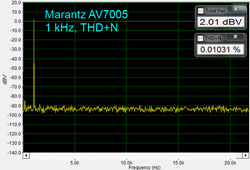
With the 1 kHz sine wave, there was THD+N of right around 0.01%.
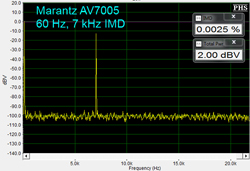
On the 60 Hz, 7 kHz IMD test, the IMD was only 0.0025%, with no second order peak visible.

The 19 kHz, 20 kHz test shows no B-A peak at 1 kHz, with the noise floor around 90 dBV below the peaks.
With most processors and receivers now having video scalers built into them, we’re working to add a new set of standard bench tests to see how they handle video. While HDMI video should stay bit-perfect as it moves through the component, it doesn’t much of the time for a variety of reasons. To test how the Marantz handled this, I used an Oppo BDP-83 which lets me control the format of data sent over HDMI, as well as the Spears and Munsil Blu-ray for test patterns. The tests used were: Overscan, Whiter than White, Blacker than Black, Luma and Chroma Burst, Luma and Chroma Plate. These test if all the data is being passed correctly, and the results are in the table below.
As you can see, the Marantz passed almost every test except for Chroma information when fed YPrPb data in 4:4:4 format or over component video. Looking at the burst pattern, the vertical lines of the highest resolution color data were missing, and on the zone plate the edges of the screen were dark, once again showing that this information is missing. With 1080i component video signals, the left 3 pixels were also being cropped and there was a 3 pixel wide black bar on the right side of the screen instead.
Marantz has been informed of the situation and has duplicated the results in their labs, and I’m awaiting their resolution for the issue. For devices that you can control, I would not send 4:4:4 data to the Marantz. Some devices output 4:4:4 over HDMI and can’t be adjusted and these will be losing some fine detail in color which is a problem, and hopefully one that Marantz can fix with a firmware update.
We also tested the video scaler by feeding 1080i content, outputting 1080p and using the following patterns: 2:2 and 3:2 cadence, jaggies, and mixed film + video (both horizontal and vertical). In the chart below you can see that the Marantz passed all of these. In my regular TV viewing I would sometimes see the 2:2 pulldown lose its cadence lock on the ticker on ESPN, but it would quickly regain the lock in all of those cases.
Conclusion
It was a mistake of me to let the Marantz AV8003 escape when I was finished with the review. For the couple of issues that I ran into with it, the benefits were far greater. I’m not making the same mistake as I already paid Marantz and will be keeping the AV7005. The video bench results are the only area that concern me, but Marantz is looking into the issue and I’m hopeful they can find a solution to it. With its combination of features, performance, and price, I think the AV7005 is a fantastic bargain for a processor, and I’m happy to have it as the centerpiece of my home theater system.



